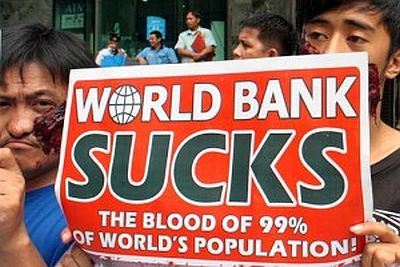“The period of McNamara’s stewardship, from 1968-1980 was instrumental in shaping the institution that we know (or should know) today: a tool of the Washington power players that is used as a way of transferring the productive wealth of the third world back to the first world. The larger capital that was raised during his tenure was used to expand the bank’s lending activities, and those expanded loans kicked off the era of the third world debt crisis, including a period from 1976 to 1980 where developing world debt rose on average 20% per year.” – J Corbett
 As many have heard by now, the leaders of the so-called BRICS nations – Brazil, Russia, India, China, and South Africa – used the occasion of the 6th BRICS Summit in Brasilia, Brazil to announce the creation of the long-awaited BRICS Development Bank. Formally the “New Development Bank”, it will be based in Shanghai and capitalized with an initial $10 billion in cash ($2 billion from each of the five founding members) and $40 billion in guarantees, to be built up to a total of $100 billion.
As many have heard by now, the leaders of the so-called BRICS nations – Brazil, Russia, India, China, and South Africa – used the occasion of the 6th BRICS Summit in Brasilia, Brazil to announce the creation of the long-awaited BRICS Development Bank. Formally the “New Development Bank”, it will be based in Shanghai and capitalized with an initial $10 billion in cash ($2 billion from each of the five founding members) and $40 billion in guarantees, to be built up to a total of $100 billion.
Immediately, the press began touting the new bank as a potential rival to the current IMF / World Bank system of infrastructure development and poverty reduction in the third world. “BRICS Development Bank Could Challenge World Bank and IMF” touts US News & World Report. “BRICS Ink $50 Billion Lender in World Bank, IMF Challenge” asserts Bloomberg. The World Bank, for its part, is downplaying the rivalry, with World Bank President Jim Young Kim openly welcoming the bank at a recent meeting with Indian Prime Minister Narendra Modi. “The only competition we have is with poverty”, he told reporters at the meeting.
But all of this talk about a potential rival to the IMF and World Bank have exposed the general public’s ignorance about what exactly these institutions are and what they do.
While most are familiar with the IMF and its predatory lending practices (and those who aren’t are encouraged to acquaint themselves with the “IMF riot” strategy that was developed in the third world and is now being imported to Europe), the World Bank is less scrutinized and less understood. What is it, what does it do, and why is it important for the BRICS to challenge its hegemony in the development and poverty reduction arenas? Continue reading
